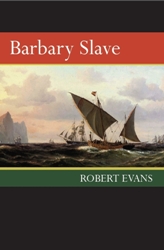 Pirates and Privateers Pirates and Privateers
The History of Maritime
Piracy
Cindy Vallar, Editor
& Reviewer
P.O. Box 425,
Keller, TX 76244-0425
    
Books for
Adults ~ Historical Fiction

Barbary Slave
by Robert Evans
CreateSpace, 2012, ISBN 978-0-9884466-1-8, US $9.96
Also available in e-book format
    
To most readers, the name
James Leander Cathcart means little. Yet
his life provides the threads that Evans,
a historical novelist, weaves together to
create a fabric of intrigue, adventure,
calamity, and triumph in Barbary Slave.
Iíve encountered Cathcartís name in my
research on Barbary corsairs, but I know
little of this manís actual life. Prior to
the opening of this novel, this
seventeen-year-old Irish immigrant served
aboard a Continental frigate during the
American Revolution and spent two years as
a prisoner-of-war aboard prison hulks in
New York, including the notorious Jersey,
before he escaped. With the end of the
war, he became a merchant seaman and, in
the summer of 1785, set sail aboard the Maria
as second mate. This is where Barbary
Slave opens.
For the most part, Jim and the first mate
oversee the day-to-day sailing of the
sloop, for her captain, who is also Jimís
uncle, spends most of his time drunk in
his cabin. Jim would prefer to sail with
his father, but he disappeared while
sailing to the Caribbean. Also lost on
that voyage is Will Melmanís father. Will,
Jimís best friend, is the Mariaís
cook, but being black and smart are
qualities not everyone appreciates. Their
journey to Cadiz is uneventful until the
sloop is becalmed off the Portuguese
coast. Without wind to fill the sails,
they quickly fall prey to Barbary pirates.
Rather than fight, the captain surrenders.
Jim, Will, and the rest of the Marias are
stripped, beaten, and imprisoned in the
putrid hold of the xebec.
Taken to Algiers, Jim is separated from
Will and becomes one of the deyís slaves.
His ingenuousness with Muslim ways and his
inability to turn base metal into gold
eventually result in him being relegated
to prison where life is far different than
what he experienced in the palace. He
endures humiliation and brutality until
SeŮor Alphonse Gaston, a slave who is also
the deyís first Christian secretary, takes
Jim under his wing. Apprenticed to various
masters, Jim slowly adapts to his new life
without free will. He acquires new skills
and languages as Gaston helps him to
navigate the hierarchy of slavery. As his
star rises, he aids his fellow crewmen and
uncle, who show only derisive ingratitude
anytime he attempts to better their lives.
Through Gaston, Jim reunites with Will,
whose path as a slave follows a different
path. He has converted to Islam, adopted
the name of Ahmed al-Hakim, and become a
janissary. His skill and bravery allow him
to rise through the ranks of this elite
military corps of the Ottoman Empire. What
little time they spend together is on the
sly, until money goes missing in the
harbor masterís accounts where Jim works.
Forgetting the lessons he has learned, he
accuses his master, who then tells the dey
that Jim is the one who stole the funds.
With his life hanging in the balance, Jim
is offered a way out of the mess heís in.
A caravan of slaves and gold, intended for
the dey, has gone missing. If Jim can
recover the items, the life he has known
will be restored. Ahmed/Will will help in
this endeavor, but the likelihood that
either of them will survive is slim. Those
who stole these items have no intention of
returning them, and Jim and Ahmed must
ally themselves with the blue-veiled
Tuareg, a nomadic warrior tribe
experiencing its own inner conflicts.
Readers seeking a rousing piratical
adventure will need to look elsewhere, for
this is a story about the victims and what
they endure. Also, Barbary Slave
will not appeal to everyone, because some
readers will object to the language and
intimate situations incorporated into the
story. Evans is upfront about this before
the story begins; while I have no problem
with using language true to the period, it
should be relegated to dialogue and the
point-of-view characterís inner
reflection, rather than being included in
a prologue without either that is purely
meant to lay the foundation of what is to
come. Evans includes a two-page glossary
at the end of the book and, while the
story provides a brief summary of
Cathcartís later years, I wish the author
had included an afterword to explain where
he veered from the facts Ė a few events
seem too fantastic to be true Ė and what
became of the historical characters in the
story, especially Cathcart and how his
eleven-year experience as a slave impacted
the rest of his life. Aside from these
caveats, I found Barbary Slave a
notable and plausible tale that provides a
breath of fresh air from the usual pirate
fare set in the Caribbean. Evansís
research and ability to recreate the world
in which Jim lives shine through.
Review Copyright ©2013 Cindy Vallar

Click to contact me
Background image compliments
of Anke's Graphics |

